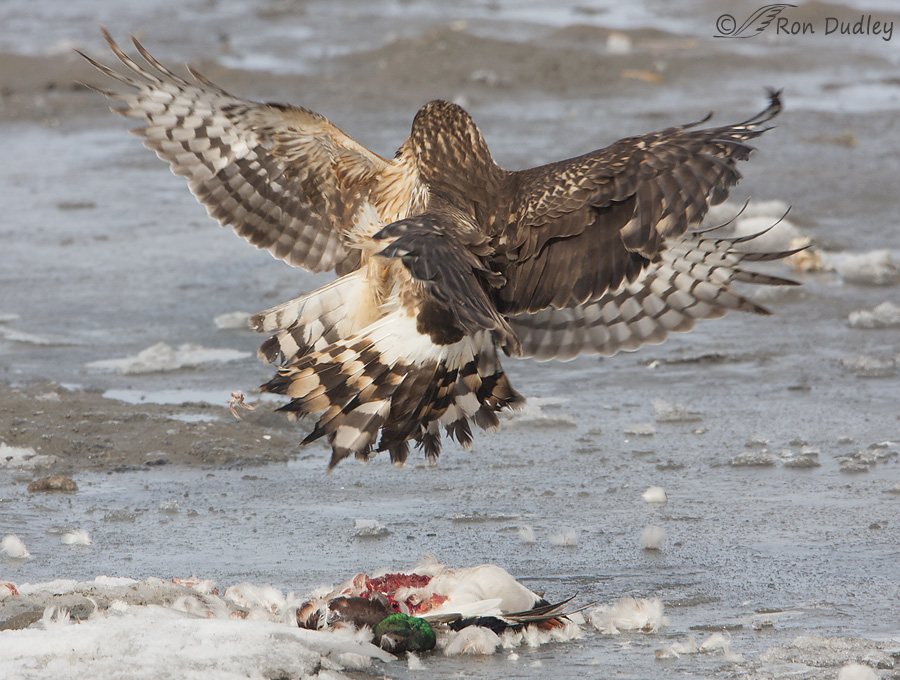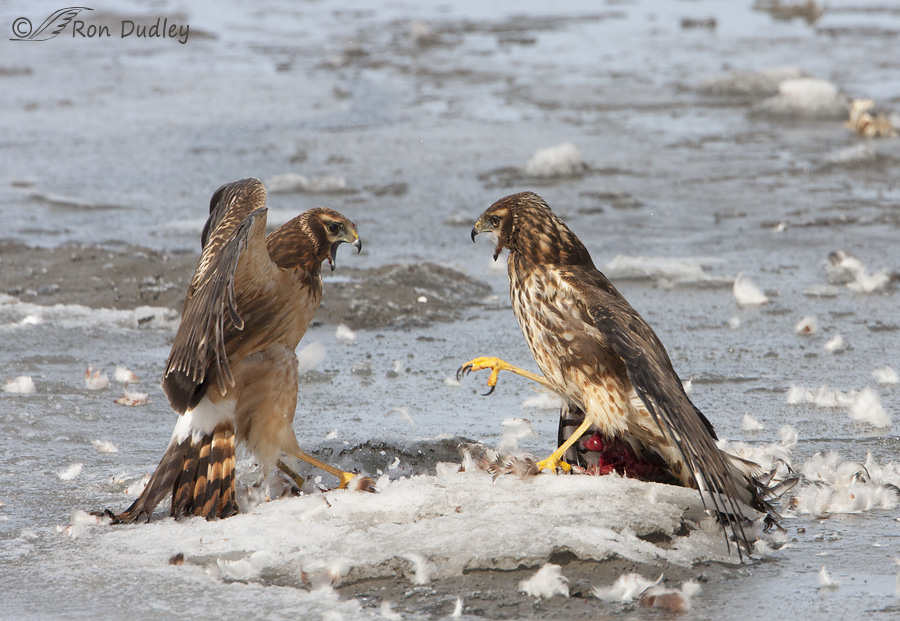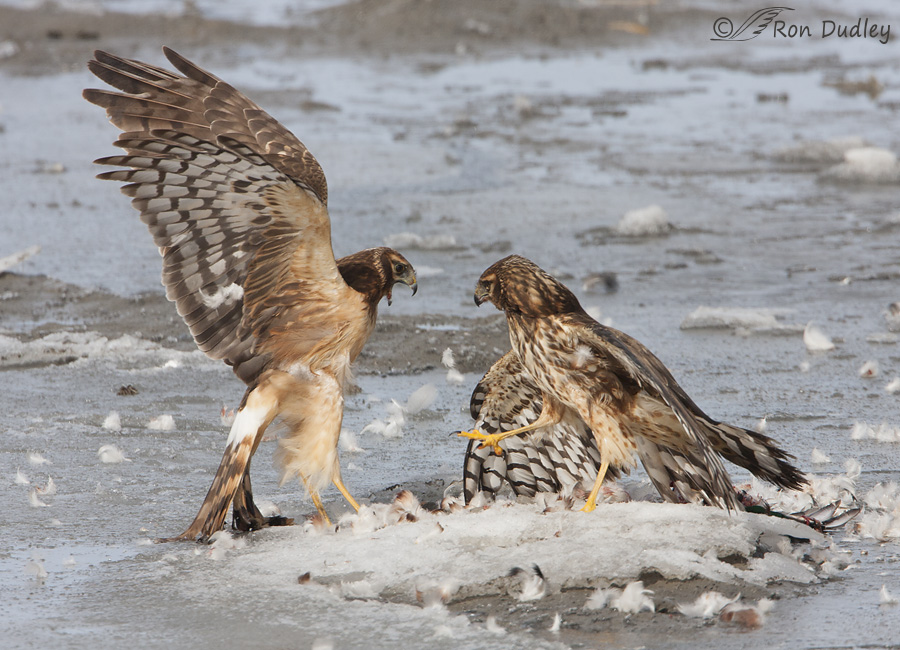I’m speaking figuratively in my title of course. Literally they were seeing exactly eye to eye.
The winter of 2008 was a harsh one in northern Utah and Northern Harriers at Farmington competed intensely for every morsel of available food. One February morning I photographed many different harriers over a period of several hours as they battled over a dead Mallard on the ice. Over the years I’ve posted a variety of photos from those sessions but these three are new to my blog.

1/1250, f/10, ISO 500, Canon 40D, Canon EF 500mm f/4L IS USM + EF 1.4 II Extender, not baited, set up or called
This photo illustrates both the intensity of the competition and the reason for it – the Mallard directly below the two harriers. I’ve never posted this shot in the past because we have to look closely to distinguish one bird from another and there’s not a face or an eye to be seen.
The viewer has to imagine what’s actually going on in the very limited space between the two birds, be it clawing with talons, biting, wing slapping or a combination of the three. And sometimes our imagination is even more vivid than reality so I enjoy looking at this photo and imagining what I’d be seeing with a side view. Whatever it was it was obviously intense.

1/1250, f/10, ISO 500, Canon 40D, Canon EF 500mm f/4L IS USM + EF 1.4 II Extender, not baited, set up or called in
64 minutes later I photographed these two harriers (presumably different birds than those in the previous photo) fighting over what was left of the duck. Their primary offensive weapons are their talons and those long legs can and often do strike out at an opponent with lightning speed. The hawk on the left is obviously wary of just such a strike. The duck is under the tail of the bird on the right.
- Every time I look at this image I wonder what that large glob of red is under the rump of that bird so this morning I finally investigated by cropping in tightly on that area. It appears to be an internal organ, perhaps the heart or spleen. Now I don’t have to wonder any more…

1/1250, f/10, ISO 500, Canon 40D, Canon EF 500mm f/4L IS USM + EF 1.4 II Extender, not baited, set up or called in
These were their postures three frames later in the burst (a slow burst for sure given the much older Canon 40D I was using). It was so long ago I can’t remember how this particular squabble turned out but I photographed fighting harriers at this carcass for some time after these photos were taken. The white puffs on the ice are duck feathers that had been scattered by the flurries of activity over such a long time.
My extended session at this duck carcass was one of the best photo-ops with harriers I’ve ever had but I’ve always felt badly for the hawks. Given the unusually frigid winter they were literally fighting for survival and I’m sure many of them didn’t make it until spring.
Ron


These are amazing images of harriers Ron! You really captured the intensity of their fight over the duck carcass. The last image in the sequence gives a nice view of how long-legged N. Harriers are. All the better to grab onto prey through thick layers of grass / vegetation.
Simply outstanding shots! I’m heartened that most kerfluffles with raptors are more bluff than bluster, but in order for the bluff to work, it’s got to look good. And those birds certainly make it look good!! And yes, survival is harsh. I often wonder about people when they romanticize life in the wild. I wonder how long they’d survive in The Great Out There! 😉
Laura, you’re absolutely right about “more bluff than bluster” – that’s usually the case. But with these harriers that winter there was significant bluster too. For example I have shots of one harrier with its talons buried in the chest of its rival.
Nice shots again Ron, like the tale along with it. I missed a hawk this morning. Saw him land in a tree a hundred or so yards away but then could not spot him as I moved up, so stood there ten minutes or so thinking he had flown off. The woods are pretty dense in Georgia. As I turned to walk away, he flew out of the tree. How I missed seeing him….. but at least I know the tree he likes to use now.
Been there, done that, Ron. They can make me feel pretty silly sometimes…
Awesome behavioral shots Ron!
Charlotte
Thank you, Charlotte.
So much desperation. So much need. So much incredible beauty.
And yes, like Patty and others I would be tempted to intervene.
EC, I don’t think I’m ever tempted to intervene in a natural event like this but it sure breaks my heart to see it sometimes.
I don’t intervene, but it doesn’t stop the yearning. So yes, I do understand.
When I see shots like this, guess at the desperation behind their actions, and hope neither bird mortally wounds the other,it makes me want to head for the nearest supermarket, buy up all their chickens and toss them onto the ice…Sometimes I feel like “Screw you, Mother Nature!”
Patty, a few years ago some folks did just that – threw them a chicken or two. But it wasn’t done for the benefit of harriers and other raptors – it was done by “nature photographers” to bait harriers and eagles to more photogenic locations.
CREEPS!!! Bet they cheat on their taxes, their spouses . at solitaire,their golf scores and everything else…
Patty, I had the same thought! Also, I may or may not have ever interfered with “survival of the fittest” when certain selection stressors went into high gear.
Wow! Such an intense series! In the first shot there’s a clump of feathers that looks to be tinged with blood falling just to the left of the tails. The feathers look a little narrow for duck feathers, so I wonder if those talons actually connected midair. I’m curious as to others’ takes on the former feather owner’s identity.
Marty, I noticed those feathers when I was processing the image. I’d only be guessing at their original owner though…
A fascinating series, Ron. And while I’m well aware life in the wild can be very harsh, that second photo, particularly, makes me sad. Both hawks look desperate. Probably doesn’t help that I’ve been listening to NPR this morning and am feeling somewhat desperate myself. 😑
I think they WERE desperate, Chris. It was a very tough winter. And I know what you mean about NPR…
Eye to eye, beak to beak , and talons talons..always .fighting for survival one way or another…an amazing sight to see–and record….
Thank you, Patty. It was a morning I’ll never forget. Someday, if our paths ever actually cross, I’ll tell you the “rest of the story…”
Boy! That’s a teaser!!! I could die of curiosity and it would be all your fault,,,!!!!
Great shots as usual Ron.
If we live in a secure bubble we can only empathize. If we have to deal with day to day finding food in the wild and survive this series become more poignant!
Life is a fight and we all should try and preserve it!
Sorry, first 100 days is worrying me tremendously.
Thanks, Dick. I have similar concerns…
Ibam scared sh–less!!!!!!!!
For those of us who sometimes think our life is not easy, we need to pay more attention to what other creatures go through to survive. These birds leave me feeling grateful to have a comparatively easy life. And I am impressed with these shots of the Harriers’ action, as I have been with other posts from that day. I love that I get to see these behaviors through your lens.
You make a very good point, Susan. Thank you.
Ron, great shots. Were these taken with manual focus? My 70D does not auto focus with a 1.4 extender?
Jim – no, I was using AF. With the 40D and this combo AF works but it wouldn’t with a 2x extender. It also worked with my much older Canon XTi. I guess I’m surprised that it doesn’t work with the 70D but I know next to nothing about that camera.
I suspect that your issue with AF might be because you’re using a lens slower than f/4?
Ron, you never fail to astound me with your photographic skill, insight and compassionate description of real life in nature.
Thanks very much, Robert.
They do get vicious over food for sure! Need to fight for it and yet I often wonder if the energy expended is worth it. We get coyote/eagle/hawk/crows/magpies all competing for deer carcass here which also gets vicious when it’s cold. Beautiful shots and documentation of the fray. 🙂
” I often wonder if the energy expended is worth it”
I’ve wondered the same thing, Judy but over the long haul it must be worth it or I think the aggressive behavior would be selected against.